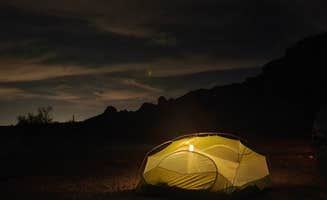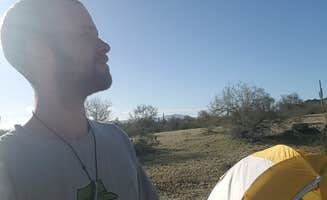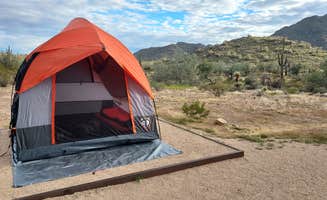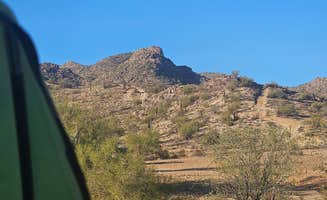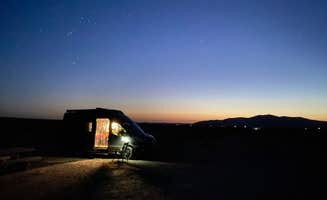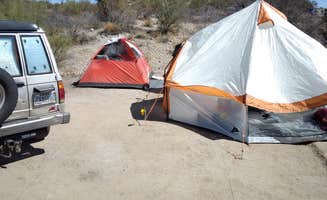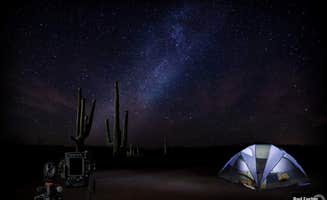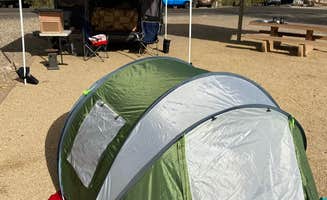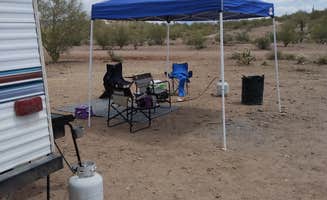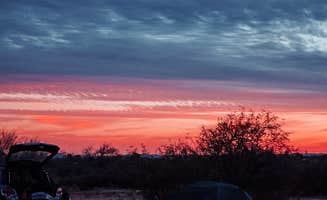Dispersed camping around Tonopah, Arizona provides desert solitude with minimal facilities and variable access conditions. The region sits at approximately 1,200 feet elevation with temperature extremes ranging from below freezing in winter to 115°F in summer. Most camping spots require high-clearance vehicles for approach, with rocky terrain and unmarked paths leading to the more secluded sites.
What to do
Petroglyphs exploration: The Painted Rock Petroglyph Site offers accessible ancient rock art viewing. "The Petroglyphs are awesome but not much else going on here. Stay a night and see it all in 15 minutes," notes Dave B. about this Painted Rock Petroglyph Site And Campground.
Mountain biking: Skyline Regional Park provides extensive trail networks. "There are several hiking trails directly accessible from the campground and all the trails are well-marked. There is a short (.6 mile) ADA-accessible trail," reports Lee D. about Skyline Regional Park.
Rock hunting: Saddle Mountain BLM area attracts rock collectors searching for agates. "We road our E bikes all over and did some agate hunting with wonderful success!" shares Wendie K., highlighting the diverse activities available at this popular dispersed site.
Hot springs soaking: El Dorado Hot Springs offers mineral pools for relaxation. "We had a soak in a private pool. I'm not sure how hot the other soaking areas are, but I would characterize ours, the Sunset, as pleasantly warm, but not hot," says Ray & Terri F.
Wildlife observation: Watch for desert animals, particularly in early morning or evening hours. "Woke up to a donkey eating out watermelon, making donkey noises and rolling on the ground so cute!!" describes Jeana R. from Lake Pleasant Regional Park Campground.
What campers like
Dark skies for astronomy: The Tonopah region offers exceptional stargazing conditions. "Amazing campsite setting nestled against the Saddle Mountains. Beautiful Sunsets & Sunrises. Stargazing is spectacular. You won't regret it!" shares Dustin N. about Saddle Mountain BLM.
Spacious, private sites: Most campsites provide ample room between neighbors. "The sites are gravel, a good size, well-maintained, and spaced a decent amount of distance apart. Some are pull-through and some back-in," observes Lee D. about White Tank Mountain Regional Park.
Desert landscape: The Sonoran environment features unique flora and geology. "Really cool place something for everybody if ur active an wanna see nature an good views or if you just want a nice relaxing place to get away but don't gotta go to far," says tay M. about White Tank Mountain Regional Park.
Clean facilities: Many established campgrounds maintain well-kept amenities. "Cleanest flush toilets and showers (free) I've ever seen in a campground. Dish washing station," reports Ryan W., highlighting the unexpected comforts at White Tank Mountain Regional Park.
Convenience to Phoenix: Most camping areas sit within 1-2 hours of Phoenix. "Another Maricopa County parks campground which is great for hiking and relaxing. Very well taken care of," writes Ellen W., noting how White Tank provides wilderness proximity while remaining accessible to urban amenities.
What you should know
Temperature extremes: Summer desert camping requires careful planning. "Got in pretty late at night on a Friday but had no difficulty finding a spot. Road was a little rocky but not horrible. Gorgeous views all around, and you can drive far enough back to really lose the road sounds. It was pretty hot, as would be expected here, but the breeze through the night was enough to keep us cooled off with the tent vents opened," explains Steffanie & Joshua.
Seasonal crowds: Winter brings higher visitor numbers. "This is a nice basic BLM camp ground. Clean pit toilets, but only two of them for the 60 camp sites," notes M W. about Painted Rock Petroglyph Site And Campground, highlighting the limited facilities during busy periods.
Road conditions: Access roads vary significantly in quality. "Somewhat curvy blacktop to campground. Sites are gravel and all pretty level. We like exposure for solar, which was good because there is no shade. Pit toilets and trash dumpsters. No water or dump," James B. details about Painted Rock Petroglyph Site.
Water availability: Most dispersed sites require bringing all water. "No water. Neither potable or non-potable," warns Castaway I. about Skyline Regional Park, emphasizing the importance of arriving prepared.
Cell service: Coverage varies widely between camping areas. "AT&T coverage was quite good, with 2-3 Bars of 5GE service and speeds up to 17 MB/s," reports Ray & Terri F. about El Dorado Hot Springs.
Tips for camping with families
Consider partial hookup sites: Family campgrounds offer basic amenities. "The campground itself is very clean, including the restrooms and showers. It is quiet and the campsites all have electric and water hookups, picnic table and fire pit. Sites are far enough from each other so it doesn't feel crowded," advises Ellen W.
Visit in spring for flowers: March-April brings desert blooms. "Lush desert campground. Quiet and well run. Very clean," says Lynn C. about White Tank Mountain, where seasonal wildflowers create educational opportunities for children.
Check for proximity to playgrounds: Some parks offer dedicated play areas. "The park has beautiful hiking trails and a great nature center, which offers activities and the regional library. There are a couple of playgrounds in the park as well," notes Ellen W.
Look for short, accessible trails: Several parks offer kid-friendly paths. "There is a nice trail to Waterfall Canyon which is heavily used but worth it. There are a number of petroglyphs from the Hohokam culture that you can see," Christine S. shares about White Tank Mountain.
Prepare for insect encounters: Desert bugs can be numerous. "Pros: The views are absolutely beautiful, sites are spaced out, quiet and clean, most roads almost any car can make it there are a few that requires a truck. Cons: Flies are horrendous out here, no matter what you try to do to keep them away or out it's almost impossible to do!" warns Damon H.
Tips from RVers
Arrive with full tanks: Limited water and dump facilities necessitate preparation. "No services as far as water, power or dump station. Nice sunsets, and trails to hike. Bring your own water," advises M W. about Painted Rock Petroglyph Site.
Check site length restrictions: Some parks limit RV sizes. "It cost an additional $8 per night. Their was a dump station at the entrance of the rv park for everyone else," notes George K. about the pricing structure at White Tank Mountain Regional Park.
Scout routes first: Some access roads require careful navigation. "We chose this spot based on reviews. It did not disappoint. Great spot. A few campers, but so quiet and courteous. The land goes way back to the mountain, you can go deeper as there are many more level spots beyond the main area. Will need a smaller RV to fit the narrow rocky road, scout first before rolling out back," advises Wendie K.
Consider solar capabilities: Many sites offer unobstructed sun exposure. "Sites are gravel and all pretty level. We like exposure for solar, which was good because there is no shade," James B. mentions about Painted Rock, highlighting a benefit for self-contained RVers with solar panels.
Verify generator policies: Rules vary between campgrounds. "This was just an overnight stop. You can get right up next to the mountain if you want. Very rocky though. I made it with a 35' skoolie. Just go slow. It was fairly busy," shares mike J. about maneuvering larger rigs at Saddle Mountain BLM.


